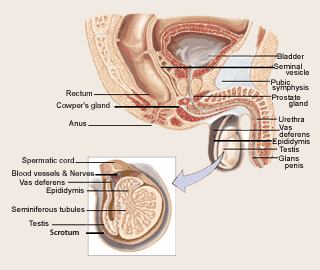What we
know...
 The exact cause of most cases of
testicular cancer is not known. However, scientists have found that the
disease is associated with a number of other conditions, which are
described in the section "What Are the Risk Factors for Testicular Cancer?"
A great deal of research is being done to learn more about the causes.
The exact cause of most cases of
testicular cancer is not known. However, scientists have found that the
disease is associated with a number of other conditions, which are
described in the section "What Are the Risk Factors for Testicular Cancer?"
A great deal of research is being done to learn more about the causes.
During the past few years, researchers have learned much about certain
changes in chromosomes and DNA that may cause normal testicular germ
cells to develop into germ cell tumors. Chromosomes are giant molecules
of DNA and protein that carry genetic information about inherited
traits. Each sperm or egg cell has half as many chromosomes as other
body cells. So, when the sperm and egg combine, the resulting fetus has
a normal number of chromosomes --half of which are from each parent.
This is why we tend to look like our parents.
Meiosis is the process by which germ cells with 46
chromosomes develop into sperm or egg cells with 23 chromosomes.
Testicular germ cell tumors may form when something abnormal happens
during meiosis. Instead of forming normal sperm cells with 23
chromosomes, all 46 chromosomes remain. Usually, these chromosomes
become unstable and progressively more abnormal in their shape and
number (often between 69 and 82). Testicular cancer cells often have
extra copies of a part of chromosome 12 (this is called isochromosome
12p). Scientists are studying DNA from this chromosome to learn more
about exactly what goes wrong during meiosis and how this might be
prevented or reversed.
Several other abnormal chromosomes and changes in
the factors that regulate cell division and the cell cycle have been
associated with testicular cancer, both in animals and in humans. All
of these changes are being studied to find the true causes of
testicular cancer.
